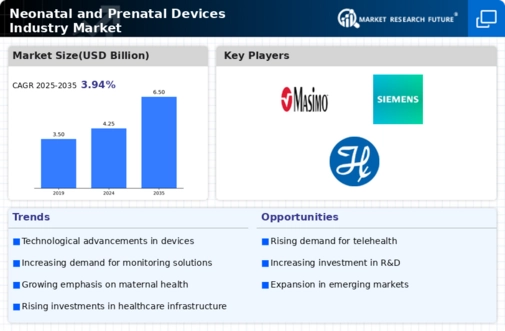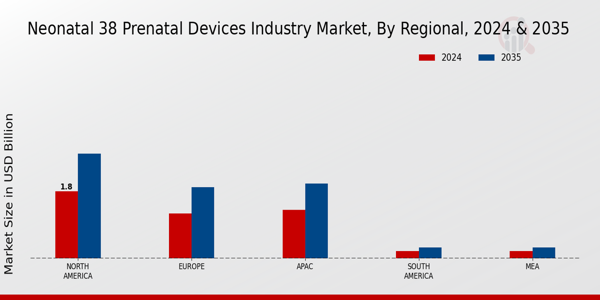Market Growth Projections
Rising Healthcare Expenditure
An upward trend in healthcare expenditure globally is a crucial driver for the Global Neonatal and Prenatal Devices Industry Market. As countries allocate more resources to healthcare, investments in advanced medical technologies, including neonatal devices, are likely to increase. This trend is particularly evident in developing nations, where improving healthcare infrastructure is a priority. The anticipated growth in the market value to 6.5 USD Billion by 2035 reflects this investment trend. Enhanced funding for healthcare initiatives enables the procurement of state-of-the-art neonatal devices, ultimately improving care for newborns.
Government Initiatives and Funding
Government initiatives aimed at improving maternal and child health are pivotal drivers of the Global Neonatal and Prenatal Devices Industry Market. Various countries are implementing programs to enhance access to prenatal care and neonatal services, often supported by increased funding. For instance, initiatives that promote the use of advanced neonatal devices in hospitals are likely to lead to better health outcomes. Such policies not only foster innovation but also encourage manufacturers to develop more effective devices. This supportive environment is expected to sustain market growth, particularly as awareness of neonatal health issues rises.
Rising Prevalence of Neonatal Conditions
The Global Neonatal and Prenatal Devices Industry Market is driven by the increasing prevalence of neonatal conditions such as preterm birth and congenital disorders. According to health statistics, approximately 15 million infants are born preterm each year, leading to a heightened demand for specialized neonatal devices. This trend is expected to contribute to the market's growth, with projections indicating a market value of 4.25 USD Billion in 2024. The need for effective monitoring and treatment solutions for these vulnerable populations underscores the importance of advancements in neonatal technology.
Technological Advancements in Medical Devices
Innovations in technology are significantly influencing the Global Neonatal and Prenatal Devices Industry Market. The introduction of advanced monitoring systems, such as non-invasive imaging and telemedicine solutions, enhances the ability to provide timely care to neonates. These technological advancements not only improve patient outcomes but also streamline healthcare processes. As a result, the market is anticipated to grow, reaching an estimated value of 6.5 USD Billion by 2035. The integration of artificial intelligence and machine learning in neonatal devices further exemplifies the potential for improved diagnostics and treatment.
Growing Awareness of Maternal and Infant Health
The Global Neonatal and Prenatal Devices Industry Market benefits from the increasing awareness surrounding maternal and infant health. Educational campaigns and public health initiatives are raising consciousness about the importance of prenatal care and the use of specialized devices. This heightened awareness is likely to drive demand for neonatal devices, as parents and healthcare providers seek the best possible outcomes for infants. The market's growth trajectory is supported by this trend, with a projected compound annual growth rate of 3.94% from 2025 to 2035, reflecting the ongoing commitment to improving neonatal care.





